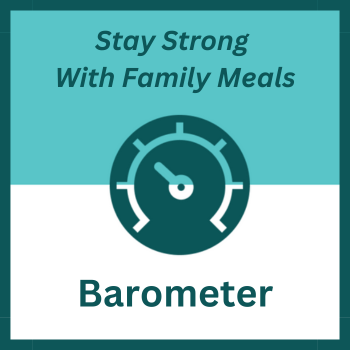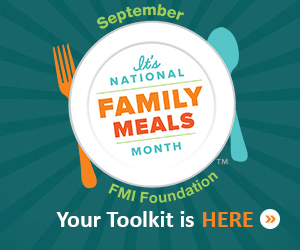Supporting Research
More than 35 years of research and thousands of studies from around the globe document that family meals (no matter how you define “family”) are advantageous for both physical and mental health. Beyond these benefits, it has been shown time and again that family meals improve family functioning – family connectedness, communication, expressiveness, and problem-solving.
We may have always known, intuitively, that family meals are good for us, but the numerous research studies from the past ten years alone (cited below) provide scientific proof. See for yourself.
Remarkable Mental Health Benefits for All Involved
This example1 illustrates the ways that family meals can be a place for change, begun in therapy, and implemented at home. Family meals and family therapy confer many similar benefits to family members and they are both settings in which families can connect and interact as a group, in a designated space and time. Family therapists can work with families in several ways to harness the benefits of family dinners as an annex to therapy and as a place to experiment with new roles, behaviors and patterns of communication that can be enacted on a daily basis after being discussed in therapy.
1 Fishel, Anne K. "Harnessing the Power of Family Dinners to Create Change in Family Therapy." Australian & New Zealand Journal of Family Therapy, 2016.
A growing body of research suggests that children and adolescents who share frequent meals with their families report better nutrition indicators, family relationships and mental health. But they are not the only ones who benefit – so do the adults in the room! This paper2 uses population-based survey data and a sample of parents in the United States that responded to the fourth wave of the Project EAT study in 2015-16. Results suggest that parents report frequent family meals are associated with higher levels of family functioning, greater self-esteem, and lower levels of depressive symptoms and stress. Findings from the study suggest that frequent family meals may contribute to the social and emotional well-being of parents.
2 Utter, Jennifer et al., "Family meals among parents: Associations with nutritional, social and emotional wellbeing." Preventive Medicine, 2018.
Emotional Survival Skills
This study3 examines the prospective associations between the environmental quality of the family meal experience at age six years and child well-being at age 10. When children were age six, parents reported on their typical family meal environment quality. At age 10, parents, teachers, and children themselves provided information on lifestyle habits, academic achievement, and social adjustment, respectively. Results show that family meal environment quality at age six predicted higher levels of general fitness and lower levels of soft drink consumption, physical aggression, oppositional behavior, nonaggressive delinquency, and reactive aggression at age 10. These findings suggest that family meals have long-term influences on children's biopsychosocial well-being.
3 Harbec, Marie-Josée and Pagani, Linda S. "Associations Between Early Family Meal Environment Quality and Later Well-Being in School-Age Children." Journal of Developmental & Behavioral Pediatrics, 2018.
Findings from a recent study4 suggest that family meals buffer daily risks associated with familial conflicts. Adolescents completed diary checklists for up to 14 days, reporting their emotions, experiences of family and peer conflict, and whether they ate with their family that day. On days when adolescents shared a family meal, they felt greater happiness and role fulfillment, and less burnout and distress. Moreover, family conflict was associated with more negative emotionality only on days that adolescents did not also eat with the family.
4 Armstrong-Carter, Emma and Telzer, Eva H. "Family meals buffer the daily emotional risk associated with family conflict." Developmental Psychology, 2020.
One study5 that was designed to examine the association between the frequency of family dinners and positive and negative dimensions of mental health in adolescents finds that the frequency of family meals minimized internalizing and externalizing symptoms while increasing emotional well-being, prosocial behavior and life satisfaction.
5 Elgar, Frank J. et al. "Family dinners, communication, and mental health in Canadian adolescents." Journal of Adolescent Health, 2013.
A different study6 that examines the relationship between family meals and adolescent mental health and relationship differences by sex finds that frequent family meals may have a protective effect on the mental health of adolescents, particularly for depressive symptoms in girls. Authors recommend that interventions that aim to increase the frequency of family meals are needed to evaluate whether family meals alone can have an emotional benefit for adolescents.
6 Utter, Jennifer et al. "Family Meals and Adolescent Emotional Well-Being: Findings From a National Study." Journal of Nutrition Education and Behavior, 2016.
A 2013 study7 describes the relationships between family meals and family connectedness, parental monitoring and parent-child communication and explores if frequent family meals are associated with better mental well-being and fewer risk-taking behaviors among adolescents. The findings suggest that family meals may provide a unique opportunity for building stronger families and young people. Creating environments where frequent family meals are normative, valued and feasible for families may result in benefits for young people that extend beyond good nutrition.
7 Utter, Jennifer et al. "Family meals and the well-being of adolescents." Journal of Paediatrics and Child Health, 2013.
A systematic review8 to study the effects of frequent family meals on psychosocial outcomes in children and adolescents, and to examine whether there are differences in outcomes between males and females, provides further support that frequent family meals should be endorsed. Results of the review show that frequent family meals are inversely associated with disordered eating, alcohol and substance use, violent behavior, and feelings of depression or thoughts of suicide in adolescents. Additionally, there is a positive relationship between frequent family meals and increased self-esteem and school success. Studies show substantial differences in outcomes for male and female children and adolescents, with females having more positive results. Researchers concluded that health care practitioners should educate families on the benefits of having regular meals together as a family.
8 Harrison, Megan E. et al. "Systematic review of the effects of family meal frequency on psychosocial outcomes in youth." Canadian Family Physician, 2015.
A comprehensive literature review9 examining the association between family meals and eight adolescent risk outcomes: alcohol, tobacco, marijuana and other drugs; aggressive and/or violent behaviors; poor school performance; sexual behavior; mental health problems; and disordered eating patterns finds associations in the relationship between family meals and adolescents' risk profiles. More specifically, studies reporting significant associations find that adolescents who frequently eat meals with their family and/or parents are less likely to engage in risk behaviors when compared to peers who never or rarely eat meals with their families. The studies examined indicate that family meals may be protective and, therefore, have practical implications for parents, clinicians, and organizations looking to reduce adolescent risk behaviors.
9 Skeer, Margie R. and Ballard, Erica L . "Are family meals as good for youth as we think they are? A review of the literature on family meals as they pertain to adolescent risk prevention." Journal of Youth and Adolescence, 2013.
Regularly eating breakfast and meals with family has important health implications for youth. Utilizing the 2009-2010 World Health Organization's Health Behavior in School-Aged Children U.S. survey, researchers sought to begin this conversation. Their findings suggest that eating breakfast and meals with parents more regularly may be related to more positive body image. This cross-sectional glance10 suggests that policies and programs that encourage youth and families to regularly eat breakfast and family meals may also encourage better body image among youth.
10 Winter, Virginia Ramseyer et al. "Eating Breakfast and Family Meals in Adolescence: The Role of Body Image." Social Work in Public Health, 2019.
This study11 presents evidence that cyberbullying victimization relates to internalizing, externalizing, and substance use problems in adolescents and that the frequency of family dinners diminishes these associations. Researchers found that cyberbullying relates to mental health and substance use problems in adolescents, even after their involvement in face-to-face bullying is considered. Although correlational, these results suggest that family dinners (i.e., family contact and communication) are beneficial to adolescent mental health and may help protect adolescents from the harmful consequences of cyberbullying.
11 Elgar, Frank J. et al. "Cyberbullying victimization and mental health in adolescents and the moderating role of family dinners." JAMA Pediatrics, 2014.
Maximizing Nutrition and Health
Results of this randomized clinical trial12 suggest that the simple, low-threshold intervention of increasing family mealtime duration by approximately 10 minutes can improve the quality of children's diet and eating behavior. Family meals are a formative learning environment that shapes children's food choices and preferences. As such, they are an ideal setting for efforts to improve children's nutritional health. The findings underscore the potential for such an intervention to improve public health.
12 Dallacker, Mattea et al. "Effect of Longer Family Meals on Children’s Fruit and Vegetable Intake." JAMA Network Open, 2023.
This study13 examines the associations between frequency of family meals and low fruit and vegetable intake in preschool children. Researchers found that preschool-age children who have more frequent family meals eat more fruits and vegetables. Educating parents about the potential benefits of frequent shared meals may lead to a higher fruit and vegetable consumption among preschoolers.
13 Caldwell, A R et al. "Is frequency of family meals associated with fruit and vegetable intake among preschoolers? A logistic regression analysis." Journal of Human Nutrition and Dietetics, 2018.
This systematic review and meta-analysis14 of 57 studies (203,706 participants) examines the relationship between family meal frequency and various nutritional health outcomes. The findings show a significant relationship between frequent family meals and better nutritional health - in younger and older children, across countries and socioeconomic groups.
14 Dallacker, M. et al. "The frequency of family meals and nutritional health in children: a meta-analysis." Obesity Reviews, 2018.
This systematic review15 evaluates the association between frequency of family meals and nutritional status and/or food consumption in adolescents. Most investigations evaluated the frequency of breakfast, lunch, and/or dinner/supper/evening meals over a one-week period. Seventeen studies identified a positive relationship between high frequency of family meals and better nutritional status, and 26 found a positive association between high frequent family meals and better food consumption. In conclusion, this review shows an association between frequency of family meals and healthy dietary patterns, such as increased consumption of fruits and vegetables.
15 Melo, Giselle Rhaisa do Amaral e et al. "Family meal frequency and its association with food consumption and nutritional status in adolescents: A systematic review." PLOS One, 2020.
A meta-analysis16 synthesizes studies on social, environmental and behavioral attributes of family meals and identifies components of family meals that are related to better nutritional health in children. Results show that positive associations consistently emerged between five components and children's nutritional health: turning the TV off during meals, parental modeling of healthy eating, higher food quality, positive atmosphere, children's involvement in meal preparation, and longer meal duration. Researchers concluded that how a family eats together shows significant associations with nutritional health in children.
16 Dallacker, M. et al. "Quality matters: A meta-analysis on components of healthy family meals." Health Psychology, 2019.
A cross-sectional study17 examines the relationship between diet quality and frequency of family meals through childhood and adolescence (ages birth through 17 years) using data from the 2010 North Carolina Child Health and Monitoring Program. Researchers found that participating in more than five family meals per week was associated with less sugar-sweetened beverage intake among younger and older children, greater vegetable intake among older children and adolescents, and greater fruit intake among adolescents. Study authors concluded that strategies to encourage families to establish regular family meals early in life and continue them throughout childhood and adolescence is warranted.
17 Fink, Sara K. et al. "Family meals and diet quality among children and adolescents in North Carolina." Journal of Nutrition Education and Behavior, 2014.
This cross-sectional study18 finds that more frequent family dinners are associated with healthful dietary intakes among youths, regardless of level of family functioning. More frequent family dinners are associated with higher intakes of fruits and vegetables, and lower intakes of fast food and takeout foods. Additionally, more frequent family dinners are associated with lower intake of sugar-sweetened beverages for male participants. Researchers concluded that family dinners may be an appropriate intervention target for improving dietary intake among youths.
18 Walton, Kathryn et al. "Exploring the Role of Family Functioning in the Association Between Frequency of Family Dinners and Dietary Intake Among Adolescents and Young Adults." JAMA Network Open, 2018.
This study19 shows the positive influence of eating at home with the family on food consumption in a sample of Swiss children. This study investigates the people and places Swiss school-aged children ate with over a seven-day period and analyses the effects of eating at home with family on food consumption. Children completed a seven-day food diary documenting the foods they consumed, the people with whom they ate, and the place where they ate. Analyses were conducted for all meals and included 9,911 meal occasions. Most meals (80.5%) were consumed at home with family. Compared to eating in other settings (e.g., school-peers or restaurant-family), eating in the home-family setting was associated with higher consumption of vegetables (+66% and +142% at weekday lunch and dinner and +180% and +67% at weekend lunch and dinner), lower consumption of sweets (-45% and -49% at weekday lunch and dinner; -43% and -49% at weekend lunch and dinner), and fewer soft drinks (-37% and -61% at weekday lunch and dinner; -66% and -78% at weekend lunch and dinner).
19 Suggs, L Suzanne et al. "Is it better at home with my family? The effects of people and place on children's eating behavior." Appetite, 2018.
A systematic literature review20 shows that there is a positive relationship between family meal frequency and dietary outcomes in children, aged 2-18 years. There is stronger evidence for the relation with family functioning outcomes. Dietary outcomes show some evidence of a positive association between family meal frequency and fruits, vegetables, fruits and vegetables, sugar-sweetened beverages, and the Healthy Eating Index. A positive association was found between family meal frequency or dinner family meal frequency and family functioning outcomes.
20 Robson, Shannon M. et al. "Is it better at home with my family? The effects of people and place on children's eating behavior." Journal of Nutrition Education and Behavior, 2020.
Healthy Weight and Healthier Diet
A cross-sectional study21 examines associations between interpersonal and food-related family dynamics at family meals and childhood obesity status. Results show significant associations between positive family- and parent-level interpersonal dynamics (i.e., warmth, group enjoyment, parental positive reinforcement) at family meals and reduced risk of childhood overweight. In addition, significant associations were found between positive family- and parent-level food-related dynamics.
21 Berge, Jerica M. et al. "Childhood obesity and interpersonal dynamics during family meals." Pediatrics, 2014.
A longitudinal cohort study22 examines whether having family meals as an adolescent protects against becoming overweight or obese 10 years later as a young adult. Results show that all levels of baseline family meal frequency (i.e., 1-2, 3-4, ≥5 family meals/week) during adolescence are significantly associated with reduced odds of overweight or obesity ten years later in young adulthood as compared with never having family meals as an adolescent.
22 Berge, Jerica M. et al. "The Protective Role of Family Meals for Youth Obesity: 10-year Longitudinal Associations." The Journal of Pediatrics, 2014.
A nationwide survey23 in South Korea was conducted with 2,904 elementary students to identify the relationship between frequency of family meals and overweight/obesity in elementary students and to suggest the management and prevention strategies of childhood obesity. Survey results show that the frequency of family meals is strongly related to lower rates of childhood overweight or obesity. Therefore, authors suggest that the intervention of childhood obesity should include family meals.
23 Lee, H J et al. "Do family meals affect childhood overweight or obesity?: nationwide survey 2008-2012." Pediatric Obesity, 2016.
This research review24 aims to investigate whether the beneficial health effects of the family meal also apply to infants and toddlers. PubMed, Web of Science, Scopus and PsycInfo were searched and 14 empirical studies were identified. The limited number of studies suggest that the pattern of positive associations between family meal and child health which has been shown in older children may also exist in infants and toddlers. The associations between the family meal and less fussiness and emotional eating, more food enjoyment and better nutrient intake suggest that the family meal is a valuable moment to promote healthy eating in toddlers and infants.
24 Verhage, Chantal L. et al. "The relation between family meals and health of infants and toddlers: A review." Appetite, 2018.
Data from the 2007 National Survey of Children’s Health for children with disabilities (sample size = 4,336) are used in this study25 to examine the relationship between frequency of family meals and outcomes for children with disabilities. Findings suggest that children with disabilities whose families participate in frequent family meals have a greater likelihood of positive social and family health outcomes.
25 DeGrace, Beth W. et al. "Benefits of Family Meals for Children With Special Therapeutic and Behavioral Needs." The American Journal of Occupational Therapy, 2016.
© 2025 FMI All rights reserved.
Web design and development by Matrix Group International, Inc. ®



